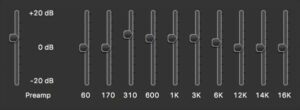People often confuse continuums with spectrums. What is the difference, you ask? Let’s compare the notes on a piano keyboard with sound, overall.
A piano keyboard plays a continuum of notes from the lowest end of the keyboard to the highest, where each note corresponds to a letter on a scale ranging from A to G. We can say that some notes are lower or higher than others.
Sound, on the other hand, does not fall on a continuum, because it is composed of more than one dimension: pitch, or frequency, (low to high as measured in Hz), and volume, or amplitude, (soft to loud as measured in decibals). If sound were on a continuum we would say that we hear “more” or “less” sound. Instead, we say the sound is louder or softer in volume and higher or lower in pitch. Each dimension of sound is a continuum.
The same is true for Autism and AD(H)D. They are both identified as a constellation of traits and symptoms. Each of those traits or symptoms is on a continuum of less to more challenging.
This is easier to understand when you look at an image of a graphic equalizer. Imagine that each number below each of the knobs corresponded to a trait, such as reading social cues, motor coordination, hyperfocus, inattention, impulsivity, or sensory sensitivities.
 Heidbreder R. AD(H)D symptomatology is best conceptualized as a spectrum: a dimensional versus unitary approach to diagnosis. Atten Defic Hyperact Disord. 2015 Dec;7(4):249-69. doi: 10.1007/s12402-015-0171-4. Epub 2015 May 10. PMID: 25957598.
Heidbreder R. AD(H)D symptomatology is best conceptualized as a spectrum: a dimensional versus unitary approach to diagnosis. Atten Defic Hyperact Disord. 2015 Dec;7(4):249-69. doi: 10.1007/s12402-015-0171-4. Epub 2015 May 10. PMID: 25957598.
One individual diagnosed with Autism or AD(H)D will have greater or fewer challenges depending on each trait or symptom, giving them an overall unique constellation of traits. This is why people with the same diagnosis may look and act and perceive the world very differently.
And that, my friends, is why you can’t be “a little bit Autistic” or “a little bit AD(H)D”, of “high” or “low functioning: because Autism and AD(H)D are spectrums, not continuums. Do you think you might belong to one of these spectrums, but are unsure, try one of the quizzes!
The Art of ADHD Quiz for Adults
How much AD(H)D fabulousness do you have? Try this quiz to find out!

The Art of Autism Quiz for Adults
How much Autistic fabulousness do you have? Try this quiz to find out!
Connecting
The Dots
What is the difference between a spectrum and a continuum?
A continuum is a progression of gradually changing values on a single trait e.g., the continuum of the volume of sound is measured in decibels from low to high. A spectrum is a progression of gradually changing values on multiple traits e.g., the spectrum of sound is measured as a combination of pitch in Hz and volume in decibels.
There is no such thing as more or less sound, only lower or higher volume or pitch. Similarly, there is no such thing as being more or less Autistic, only being more or less sensitive to sound, able to hyperfocus, etc, across multiple dimensions of Autism.
The spectrum relates to:
A constellation of traits related to social, emotional, cognitive, sensory, and motor perceptions and behaviour
Every neurodivergent person has a unique constellation of traits that give them advantages and disadvantages
Individuals with some constellations of traits have higher support needs while others have lower support needs
The degree of support offered should not be based on visible differences in physical or intellectual capacity but on a complete assessment across all dimensions




